Soil Compaction Induced by Three Timber Extraction Options: A Controlled Experiment on Penetration Resistance on Silty-Loamy Soils
Abstract
:Featured Application
Abstract
1. Introduction
2. Materials and Methods
2.1. Study Sites and Soil Characteristics
2.2. Experimental Design and Data Collection
2.3. Data Processing and Statistical Analysis
3. Results
3.1. Penetration Resistance in the Natural Soil
3.2. Changes in the Trafficked Soil
3.3. Significance of Changes following the Tests
4. Discussion
5. Conclusions
Author Contributions
Funding
Institutional Review Board Statement
Informed Consent Statement
Data Availability Statement
Acknowledgments
Conflicts of Interest
Appendix A
| Mean | Summary Description | Unloaded Weight (tons) |
|---|---|---|
| Horses + cart | Four-wheel cart, made of wood and a steel frame, with a maximum loading capacity of about 2 tons, which depends on the size and arrangement of the logs, tires used during the study are 195/70R14, weight: 500 kg, length 3.5 m, depth 50 cm, width 60 cm, horse weight 550 kg. | 0.6 |
| Forwarder | Eight-wheel-drive specialized machine, with a maximum loading capacity of 16 tons, which depends on the size and arrangement of the logs. Brand: John Deere 10.10, tires used during the study: 2720/106, front tires width 34–14, rear tires width 24.5. Diesel engine of 115.5 kW, transmission: hydrostatic–mechanical, 2-speed gearbox. Gear bogie axles at the front and the rear. Hydromechanical differential lock at the front and the ear. | 18.0 |
| Skidder | Four-wheel specialized machine. Brand: TAF 690 PE, with a maximum loading capacity of 5 tons, tires used during the study 18.4–26, external diameter 1450 mm, ballooning 465 mm, engine: Perkins 1104d-44t, 70 kW. | 7.5 |
| Dataset | Description | W—Stat | p-Value | Outcome |
|---|---|---|---|---|
| CH0-10 | Horse logging, control, soil layer from 0 to 10 cm in depth | 0.753624 | <0.001 | No |
| CH11-20 | Horse logging, control, soil layer from 11 to 20 cm in depth | 0.730276 | <0.001 | No |
| CH21-30 | Horse logging, control, soil layer from 21 to 30 cm in depth | 0.902987 | <0.001 | No |
| CH31-50 | Horse logging, control, soil layer from 31 to 50 cm in depth | 0.861223 | <0.001 | No |
| CH51-65 | Horse logging, control, soil layer from 51 to 65 cm in depth | 0.722706 | <0.001 | No |
| P1H0-10 | Horse logging, pass 1, soil layer from 0 to 10 cm in depth | 0.895026 | <0.001 | No |
| P1H11-20 | Horse logging, pass 1, soil layer from 11 to 20 cm in depth | 0.855186 | <0.001 | No |
| P1H21-30 | Horse logging, pass 1, soil layer from 21 to 30 cm in depth | 0.932094 | <0.001 | No |
| P1H31-50 | Horse logging, pass 1, soil layer from 31 to 50 cm in depth | 0.912371 | <0.001 | No |
| P1H51-65 | Horse logging, pass 1, soil layer from 51 to 65 cm in depth | 0.885944 | <0.001 | No |
| P2H0-10 | Horse logging, pass 2, soil layer from 0 to 10 cm in depth | 0.769865 | <0.001 | No |
| P2H11-20 | Horse logging, pass 2, soil layer from 11 to 20 cm in depth | 0.867089 | <0.001 | No |
| P2H21-30 | Horse logging, pass 2, soil layer from 21 to 30 cm in depth | 0.817071 | <0.001 | No |
| P2H31-50 | Horse logging, pass 2, soil layer from 31 to 50 cm in depth | 0.886358 | <0.001 | No |
| P2H51-65 | Horse logging, pass 2, soil layer from 51 to 65 cm in depth | 0.794401 | <0.001 | No |
| P3H0-10 | Horse logging, pass 3, soil layer from 0 to 10 cm in depth | 0.920714 | <0.001 | No |
| P3H11-20 | Horse logging, pass 3, soil layer from 11 to 20 cm in depth | 0.923701 | <0.001 | No |
| P3H21-30 | Horse logging, pass 3, soil layer from 21 to 30 cm in depth | 0.813737 | <0.001 | No |
| P3H31-50 | Horse logging, pass 3, soil layer from 31 to 50 cm in depth | 0.906402 | <0.001 | No |
| P3H51-65 | Horse logging, pass 3, soil layer from 51 to 65 cm in depth | 0.855369 | <0.001 | No |
| P4H0-10 | Horse logging, pass 4, soil layer from 0 to 10 cm in depth | 0.964241 | 0.005 | No |
| P4H11-20 | Horse logging, pass 4, soil layer from 11 to 20 cm in depth | 0.850766 | <0.001 | No |
| P4H21-30 | Horse logging, pass 4, soil layer from 21 to 30 cm in depth | 0.940206 | <0.001 | No |
| P4H31-50 | Horse logging, pass 4, soil layer from 31 to 50 cm in depth | 0.971071 | <0.001 | No |
| P4H51-65 | Horse logging, pass 4, soil layer from 51 to 65 cm in depth | 0.948584 | <0.001 | No |
| P5H0-10 | Horse logging, pass 5, soil layer from 0 to 10 cm in depth | 0.953332 | 0.001 | No |
| P5H11-20 | Horse logging, pass 5, soil layer from 11 to 20 cm in depth | 0.500010 | <0.001 | No |
| P5H21-30 | Horse logging, pass 5, soil layer from 21 to 30 cm in depth | 0.809513 | <0.001 | No |
| P5H31-50 | Horse logging, pass 5, soil layer from 31 to 50 cm in depth | 0.828511 | <0.001 | No |
| P5H51-65 | Horse logging, pass 5, soil layer from 51 to 65 cm in depth | 0.646207 | <0.001 | No |
| P10H0-10 | Horse logging, pass 10, soil layer from 0 to 10 cm in depth | 0.947203 | <0.001 | No |
| P10H11-20 | Horse logging, pass 10, soil layer from 11 to 20 cm in depth | 0.909640 | <0.001 | No |
| P10H21-30 | Horse logging, pass 10, soil layer from 21 to 30 cm in depth | 0.832280 | <0.001 | No |
| P10H31-50 | Horse logging, pass 10, soil layer from 31 to 50 cm in depth | 0.848009 | <0.001 | No |
| P10H51-65 | Horse logging, pass 10, soil layer from 51 to 65 cm in depth | 0.850861 | <0.001 | No |
| P15H0-10 | Horse logging, pass 15, soil layer from 0 to 10 cm in depth | 0.942074 | <0.001 | No |
| P15H11-20 | Horse logging, pass 15, soil layer from 11 to 20 cm in depth | 0.784041 | <0.001 | No |
| P15H21-30 | Horse logging, pass 15, soil layer from 21 to 30 cm in depth | 0.790054 | <0.001 | No |
| P15H31-50 | Horse logging, pass 15, soil layer from 31 to 50 cm in depth | 0.958199 | <0.001 | No |
| P15H51-65 | Horse logging, pass 15, soil layer from 51 to 65 cm in depth | 0.788169 | <0.001 | No |
| Dataset | Description | W—Stat | p-Value | Outcome |
|---|---|---|---|---|
| CS0-10 | Skidding, control, soil layer from 0 to 10 cm in depth | 0.927460 | <0.001 | No |
| CS11-20 | Skidding, control, soil layer from 11 to 20 cm in depth | 0.938280 | <0.001 | No |
| CS21-30 | Skidding, control, soil layer from 21 to 30 cm in depth | 0.818967 | <0.001 | No |
| CS31-50 | Skidding, control, soil layer from 31 to 50 cm in depth | 0.907501 | <0.001 | No |
| CS51-65 | Skidding, control, soil layer from 51 to 65 cm in depth | 0.946184 | <0.001 | No |
| P1S0-10 | Skidding, pass 1, soil layer from 0 to 10 cm in depth | 0.952266 | 0.001 | No |
| P1S11-20 | Skidding, pass 1, soil layer from 11 to 20 cm in depth | 0.915452 | <0.001 | No |
| P1S21-30 | Skidding, pass 1, soil layer from 21 to 30 cm in depth | 0.897632 | <0.001 | No |
| P1S31-50 | Skidding, pass 1, soil layer from 31 to 50 cm in depth | 0.974840 | 0.001 | No |
| P1S51-65 | Skidding, pass 1, soil layer from 51 to 65 cm in depth | 0.967426 | 0.001 | No |
| P2S0-10 | Skidding, pass 2, soil layer from 0 to 10 cm in depth | 0.975937 | 0.044 | No |
| P2S11-20 | Skidding, pass 2, soil layer from 11 to 20 cm in depth | 0.897972 | <0.001 | No |
| P2S21-30 | Skidding, pass 2, soil layer from 21 to 30 cm in depth | 0.936113 | <0.001 | No |
| P2S31-50 | Skidding, pass 2, soil layer from 31 to 50 cm in depth | 0.925082 | <0.001 | No |
| P2S51-65 | Skidding, pass 2, soil layer from 51 to 65 cm in depth | 0.957938 | <0.001 | No |
| P3S0-10 | Skidding, pass 3, soil layer from 0 to 10 cm in depth | 0.954698 | 0.001 | No |
| P3S11-20 | Skidding, pass 3, soil layer from 11 to 20 cm in depth | 0.983625 | 0.252 | Yes |
| P3S21-30 | Skidding, pass 3, soil layer from 21 to 30 cm in depth | 0.912991 | <0.001 | No |
| P3S31-50 | Skidding, pass 3, soil layer from 31 to 50 cm in depth | 0.972430 | 0.001 | No |
| P3S51-65 | Skidding, pass 3, soil layer from 51 to 65 cm in depth | 0.967552 | 0.001 | No |
| P4S0-10 | Skidding, pass 4, soil layer from 0 to 10 cm in depth | 0.973228 | 0.026 | No |
| P4S11-20 | Skidding, pass 4, soil layer from 11 to 20 cm in depth | 0.918078 | <0.001 | No |
| P4S21-30 | Skidding, pass 4, soil layer from 21 to 30 cm in depth | 0.948274 | 0.001 | No |
| P4S31-50 | Skidding, pass 4, soil layer from 31 to 50 cm in depth | 0.968375 | <0.001 | No |
| P4S51-65 | Skidding, pass 4, soil layer from 51 to 65 cm in depth | 0.964185 | 0.001 | No |
| P5S0-10 | Skidding, pass 5, soil layer from 0 to 10 cm in depth | 0.982759 | 0.167 | Yes |
| P5S11-20 | Skidding, pass 5, soil layer from 11 to 20 cm in depth | 0.932247 | <0.001 | No |
| P5S21-30 | Skidding, pass 5, soil layer from 21 to 30 cm in depth | 0.937213 | <0.001 | No |
| P5S31-50 | Skidding, pass 5, soil layer from 31 to 50 cm in depth | 0.960442 | <0.001 | No |
| P5S51-65 | Skidding, pass 5, soil layer from 51 to 65 cm in depth | 0.952326 | <0.001 | No |
| P10S0-10 | Skidding, pass 10, soil layer from 0 to 10 cm in depth | 0.966026 | 0.007 | No |
| P10S11-20 | Skidding, pass 10, soil layer from 11 to 20 cm in depth | 0.951003 | 0.001 | No |
| P10S21-30 | Skidding, pass 10, soil layer from 21 to 30 cm in depth | 0.961531 | 0.005 | No |
| P10S31-50 | Skidding, pass 10, soil layer from 31 to 50 cm in depth | 0.942539 | <0.001 | No |
| P10S51-65 | Skidding, pass 10, soil layer from 51 to 65 cm in depth | 0.950297 | <0.001 | No |
| P15S0-10 | Skidding, pass 15, soil layer from 0 to 10 cm in depth | 0.956588 | 0.001 | No |
| P15S11-20 | Skidding, pass 15, soil layer from 11 to 20 cm in depth | 0.940025 | <0.001 | No |
| P15S21-30 | Skidding, pass 15, soil layer from 21 to 30 cm in depth | 0.944214 | <0.001 | No |
| P15S31-50 | Skidding, pass 15, soil layer from 31 to 50 cm in depth | 0.952136 | <0.001 | No |
| P15S51-65 | Skidding, pass 15, soil layer from 51 to 65 cm in depth | 0.950648 | <0.001 | No |
| Dataset | Description | W—Stat | p-Value | Outcome |
|---|---|---|---|---|
| CF0-10 | Forwarding, control, soil layer from 0 to 10 cm in depth | 0.902264 | <0.001 | No |
| CF11-20 | Forwarding, control, soil layer from 11 to 20 cm in depth | 0.944645 | <0.001 | No |
| CF21-30 | Forwarding, control, soil layer from 21 to 30 cm in depth | 0.894580 | <0.001 | No |
| CF31-50 | Forwarding, control, soil layer from 31 to 50 cm in depth | 0.947589 | <0.001 | No |
| CF51-65 | Forwarding, control, soil layer from 51 to 65 cm in depth | 0.939408 | <0.001 | No |
| P1F0-10 | Forwarding, pass 1, soil layer from 0 to 10 cm in depth | 0.891729 | <0.001 | No |
| P1F11-20 | Forwarding, pass 1, soil layer from 11 to 20 cm in depth | 0.951326 | 0.001 | No |
| P1F21-30 | Forwarding, pass 1, soil layer from 21 to 30 cm in depth | 0.965290 | 0.010 | No |
| P1F31-50 | Forwarding, pass 1, soil layer from 31 to 50 cm in depth | 0.904832 | <0.001 | No |
| P1F51-65 | Forwarding, pass 1, soil layer from 51 to 65 cm in depth | 0.921543 | <0.001 | No |
| P2F0-10 | Forwarding, pass 2, soil layer from 0 to 10 cm in depth | 0.963480 | 0.004 | No |
| P2F11-20 | Forwarding, pass 2, soil layer from 11 to 20 cm in depth | 0.966809 | 0.013 | No |
| P2F21-30 | Forwarding, pass 2, soil layer from 21 to 30 cm in depth | 0.982856 | 0.220 | Yes |
| P2F31-50 | Forwarding, pass 2, soil layer from 31 to 50 cm in depth | 0.859852 | <0.001 | No |
| P2F51-65 | Forwarding, pass 2, soil layer from 51 to 65 cm in depth | 0.967687 | 0.001 | No |
| P3F0-10 | Forwarding, pass 3, soil layer from 0 to 10 cm in depth | 0.975665 | 0.041 | No |
| P3F11-20 | Forwarding, pass 3, soil layer from 11 to 20 cm in depth | 0.955123 | 0.002 | No |
| P3F21-30 | Forwarding, pass 3, soil layer from 21 to 30 cm in depth | 0.867124 | <0.001 | No |
| P3F31-50 | Forwarding, pass 3, soil layer from 31 to 50 cm in depth | 0.760003 | <0.001 | No |
| P3F51-65 | Forwarding, pass 3, soil layer from 51 to 65 cm in depth | 0.979570 | 0.025 | No |
| P4F0-10 | Forwarding, pass 4, soil layer from 0 to 10 cm in depth | 0.975122 | 0.037 | No |
| P4F11-20 | Forwarding, pass 4, soil layer from 11 to 20 cm in depth | 0.937307 | <0.001 | No |
| P4F21-30 | Forwarding, pass 4, soil layer from 21 to 30 cm in depth | 0.882888 | <0.001 | No |
| P4F31-50 | Forwarding, pass 4, soil layer from 31 to 50 cm in depth | 0.976459 | 0.002 | No |
| P4F51-65 | Forwarding, pass 4, soil layer from 51 to 65 cm in depth | 0.953716 | <0.001 | No |
| P5F0-10 | Forwarding, pass 5, soil layer from 0 to 10 cm in depth | 0.964633 | 0.005 | No |
| P5F11-20 | Forwarding, pass 5, soil layer from 11 to 20 cm in depth | 0.907568 | <0.001 | No |
| P5F21-30 | Forwarding, pass 5, soil layer from 21 to 30 cm in depth | 0.813867 | <0.001 | No |
| P5F31-50 | Forwarding, pass 5, soil layer from 31 to 50 cm in depth | 0.677712 | <0.001 | No |
| P5F51-65 | Forwarding, pass 5, soil layer from 51 to 65 cm in depth | 0.920883 | <0.001 | No |
| P10F0-10 | Forwarding, pass 10, soil layer from 0 to 10 cm in depth | 0.883488 | <0.001 | No |
| P10F11-20 | Forwarding, pass 10, soil layer from 11 to 20 cm in depth | 0.949687 | 0.001 | No |
| P10F21-30 | Forwarding, pass 10, soil layer from 21 to 30 cm in depth | 0.976191 | 0.067 | No |
| P10F31-50 | Forwarding, pass 10, soil layer from 31 to 50 cm in depth | 0.960990 | <0.001 | No |
| P10F51-65 | Forwarding, pass 10, soil layer from 51 to 65 cm in depth | 0.976890 | 0.012 | No |
| P15F0-10 | Forwarding, pass 15, soil layer from 0 to 10 cm in depth | 0.963858 | 0.004 | No |
| P15F11-20 | Forwarding, pass 15, soil layer from 11 to 20 cm in depth | 0.979501 | 0.122 | Yes |
| P15F21-30 | Forwarding, pass 15, soil layer from 21 to 30 cm in depth | 0.955966 | 0.002 | No |
| P15F31-50 | Forwarding, pass 15, soil layer from 31 to 50 cm in depth | 0.939592 | <0.001 | No |
| P15F51-65 | Forwarding, pass 15, soil layer from 51 to 65 cm in depth | 0.920231 | <0.001 | No |
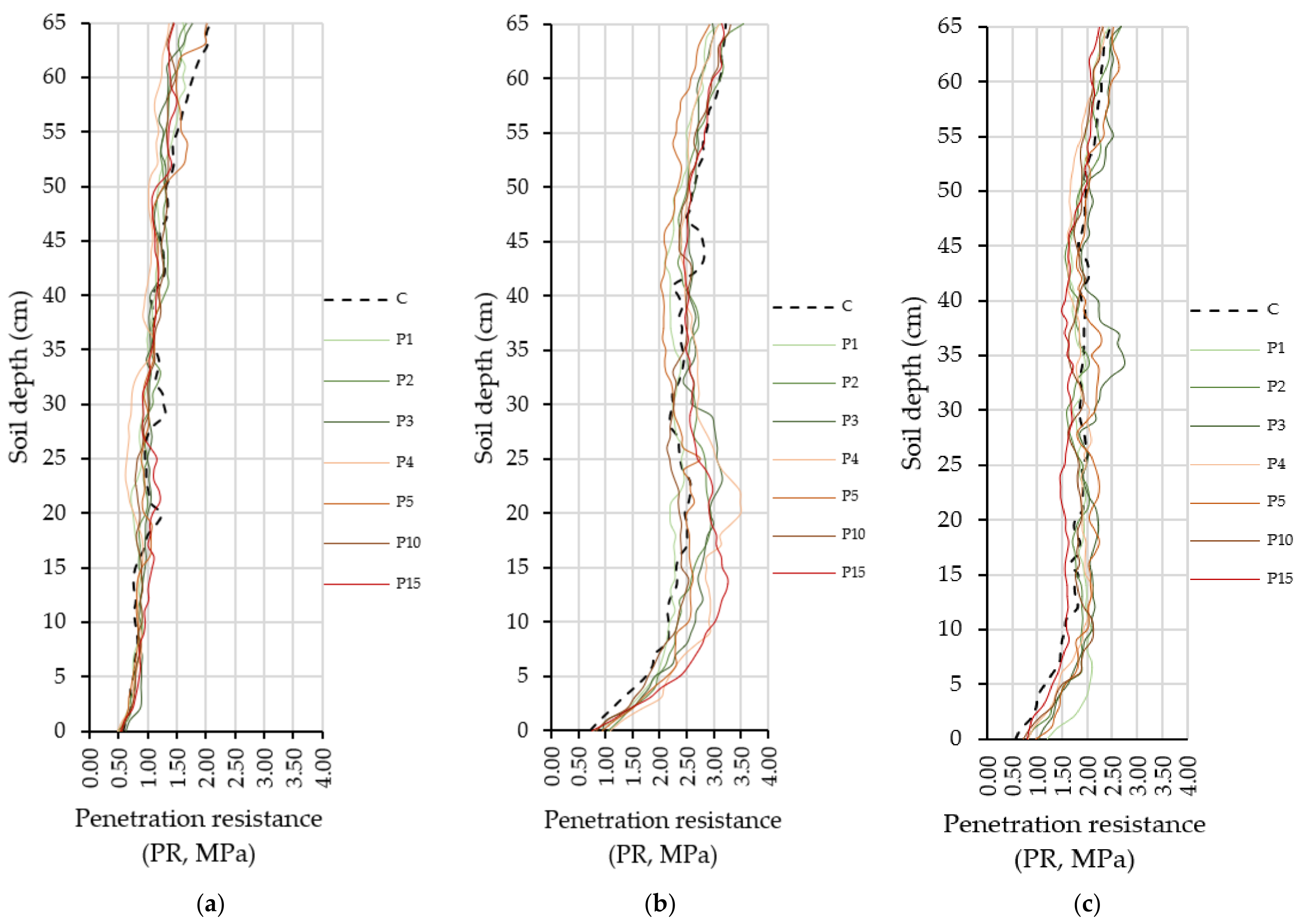
References
- Technodiversity—Harmonizing European Education in Forest Engineering by Implementing an e-learning Platform to Support Adaptation and Evaluation of Forest Operations. Available online: https://technodiversity-moodle.ibe.cnr.it/ (accessed on 22 April 2024).
- Marchi, E.; Chung, W.; Visser, R.; Abbas, D.; Nordfjell, T.; Mederski, P.S.; McEwan, A.; Brink, M.; Laschi, A. Sustainable forest operations (SFO): A new paradigm in a changing world and climate. Sci. Total Environ. 2018, 634, 1385–1397. [Google Scholar] [CrossRef]
- Heinimann, H.R. Forest operations engineering and management—The ways behind and ahead of a scientific discipline. Croat. J. For. Eng. 2007, 28, 107–121. [Google Scholar]
- Oprea, I. Tehnologia Exploatării Lemnului; Transilvania University Press: Braşov, Romania, 2008; ISBN 978-973-598-301-7. [Google Scholar]
- Jourgholami, M.; Ghassemi, T.; Labelle, E.R. Soil physio-chemical and biological indicators to evaluate the restoration of compacted soil following reforestation. Ecol. Indic. 2019, 101, 102–110. [Google Scholar] [CrossRef]
- Hansson, L.; Šimůnek, J.; Ring, E.; Bisho, K.; Gärdenäs, A.I. Soil compaction effects on root-zone hydrology and vegetation in boreal forest clearcuts. Soil Sci. Soc. Am. J. 2019, 83, 105–115. [Google Scholar] [CrossRef]
- Jourgholami, M.; Fathi, K.; Labelle, E.R. Effects of foliage and traffic intensity on runoff and sediment in skid trails after trafficking in a deciduous forest. Eur. J. For. Res. 2018, 137, 223–235. [Google Scholar] [CrossRef]
- Abari, M.E.; Majnounian, B.; Malekian, A.; Jourgholami, M. Effects of forest harvesting on runoff and sediment characteristics in the Hyrcanian forests, northern Iran. Eur. J. For. Res. 2017, 136, 375–386. [Google Scholar] [CrossRef]
- Labelle, E.R.; Jaeger, D. Soil compaction caused by cut-to-length forest operations and possible short-term natural rehabilitation of soil density. Soil Sci. Soc. Am. J. 2011, 75, 2314–2329. [Google Scholar] [CrossRef]
- Rab, M.A. Recovery of soil physical properties from compaction and soil profile disturbance caused by logging of native forest in Victorian Central Highlands, Australia. For. Ecol. Manag. 2004, 191, 329–340. [Google Scholar] [CrossRef]
- Mohieddinne, H.; Brasseur, B.; Spicher, F.; Gallet-Moron, E.; Buridant, J.; Kobaissi, A.; Horen, H. Physical recovery of forest soil after compaction by heavy machines, revealed by penetration resistance over multiple decades. For. Ecol. Manag. 2019, 449, 117472. [Google Scholar] [CrossRef]
- Naghdi, R.; Solgi, A.; Zenner, E.K.; Behjou, F.K. Soil physical properties degrade further on skid trails in the year following operations. J. For. Res. 2018, 29, 93–101. [Google Scholar] [CrossRef]
- Jourgholami, M.; Majnounian, B. Effects of wheeled cable skidder on rut formation in skid trail—A case study in Hyrcanian forest. J. For. Res. 2011, 22, 465–469. [Google Scholar] [CrossRef]
- Picchio, R.; Mederski, P.S.; Tavankar, F. How and How Much, Do Harvesting Activities Affect Forest Soil, Regeneration and Stands? Curr. For. Rep. 2020, 6, 115–128. [Google Scholar] [CrossRef]
- Naghdi, R.; Solgi, A.; Zenner, E.K.; Tsioras, P.A.; Nikooy, M. Soil disturbance caused by ground-based skidding at different soil moisture conditions in Northern Iran. Int. J. For. Eng. 2016, 27, 169–178. [Google Scholar] [CrossRef]
- Naghdi, R.; Solgi, A.; Labelle, E.R.; Nikooy, M. Combined effects of soil texture and machine operating trail gradient on changes in forest soil physical properties during ground-based skidding. Pedosphere 2020, 30, 508–516. [Google Scholar] [CrossRef]
- Parkhurst, B.M.; Aust, W.M.; Bolding, M.C.; Barrett, S.M.; Carter, E.A. Soil response to skidder trafficking and slash application. Int. J. For. Eng. 2018, 29, 31–40. [Google Scholar] [CrossRef]
- Solgi, A.; Naghdi, R.; Nikooy, M. Effects of skidder on soil compaction, forest floor removal and rut formation. Madera Bosques 2015, 21, 147–155. [Google Scholar]
- Labelle, E.R.; Jaeger, D. Quantifying the use of brush mats in reducing forwarder peak loads and surface contact pressures. Croat. J. For. Eng. 2012, 33, 249–274. [Google Scholar]
- Elaoud, A.; Chehaibi, S. Soil compaction due to tractor traffic. J. Fail. Anal. Prev. 2011, 11, 539–545. [Google Scholar] [CrossRef]
- Allman, M.; Jankovský, M.; Allmanová, Z. The cone index is a weak predictor of soil disturbance on forest soils of the Western Carpathians. J. Sustain. For. 2018, 37, 38–45. [Google Scholar] [CrossRef]
- Kleibl, M.; Klvač, R.; Pohořalý, J. Impact of forest operation on soil compaction–San Rossore case study. Acta Univ. Agric. Silvic. Mendel. Brun. 2015, 63, 1133–1140. [Google Scholar] [CrossRef]
- Aroca-Fernández, M.J.; Bravo-Fernández, J.A.; García-Viñas, J.I.; Serrada, R. Soil compaction and productivity evolution in a harvested and grazed mediterranean Scots Pine (Pinus sylvestris L.) forest. Forests 2024, 15, 451. [Google Scholar] [CrossRef]
- Han, S.K.; Han, H.S.; Page-Dumroese, D.S.; Johnson, L.R. Soil compaction associated with cut-to-length and whole-tree harvesting of a coniferous forest. Can. J. For. Res. 2009, 39, 976–989. [Google Scholar] [CrossRef]
- Lardy, J.M.; DeSutter, T.M.; Daigh, A.L.; Meehan, M.A.; Staricka, J.A. Effects of soil bulk density and water content on penetration resistance. Agric. Environ. Lett. 2022, 7, e20096. [Google Scholar] [CrossRef]
- Thomas, P.; Mondal, S.; Roy, D.; Meena, M.; Aggarwal, B.; Sharma, A.; Behera, U.; Das, T.; Jatav, R.; Chakraborty, D. Exploring the relationships between penetration resistance, bulk density and water content in cultivated soils. J. Agr. Phy. 2020, 20, 22–29. [Google Scholar]
- Solgi, A.; Najafi, A. The impacts of ground-based logging equipment on forest soil. J. For. Sci. 2014, 60, 28–34. [Google Scholar] [CrossRef]
- Dudáková, Z.; Allman, M.; Merganič, J.; Merganičová, K. Machinery-induced damage to soil and remaining forest stands—Case study from Slovakia. Forests 2020, 11, 1289. [Google Scholar] [CrossRef]
- Brais, S. Persistence of soil compaction and effects on seedling growth in northwestern Quebec. Soil Sci. Soc. Am. J. 2001, 65, 1263–1271. [Google Scholar] [CrossRef]
- Cudzik, A.; Brennensthul, M.; Białczyk, W.; Czarnecki, J. Damage to soil and residual trees caused by different logging systems applied to late thinning. Croat. J. For. Eng. 2017, 38, 83–95. [Google Scholar]
- Cambi, M.; Grigolato, S.; Neri, F.; Picchio, R.; Marchi, E. Effects of forwarder operation on soil physical characteristics: A case study in the Italian alps. Croat. J. For. Eng. 2016, 37, 233–239. [Google Scholar]
- Mousavi, F.; Abdi, E.; Ghalandarayeshi, S.; Page-Dumroese, D.S. Modeling unconfined compressive strength of fine-grained soils: Application of pocket penetrometer for predicting soil strength. Catena 2021, 196, 104890. [Google Scholar] [CrossRef]
- Allman, M.; Dudáková, Z.; Jankovský, M.; Vlčková, M.; Juško, V.; Tomčík, D. Soil compaction after increasing the number of wheeled tractors passes on forest soils in west Carpathians. Forests 2022, 13, 109. [Google Scholar] [CrossRef]
- Picchio, R.; Neri, F.; Petrini, E.; Verani, S.; Marchi, E.; Certini, G. Machinery-induced soil compaction in thinning two pine stands in central Italy. For. Ecol. Manag. 2012, 285, 38–43. [Google Scholar] [CrossRef]
- Nikooy, M.; Ahrari, S.; Salehi, A.; Naghdi, R. Effects of rubber-tired skidder and farm tractor on physical properties of soil in plantation areas in the north of Iran. J. For. Sci. 2015, 61, 393–398. [Google Scholar] [CrossRef]
- IRUM. 2024. Available online: https://www.irum.ro/en/machinery/skidder/ (accessed on 21 April 2024).
- Moskalik, T.; Borz, S.A.; Dvorák, J.; Ferencik, M.; Glushkov, S.; Muiste, P.; Lazdinš, A.; Styranivsky, O. Timber harvesting methods in Eastern European countries: A review. Croat. J. For. Eng. 2017, 38, 231–241. [Google Scholar]
- Results of the National Forest Inventory, Cycle II. Available online: https://roifn.ro/site/rezultate-ifn-2/ (accessed on 26 April 2024).
- Naghdi, R.; Solgi, A.; Zenner, E.K.; Najafi, A.; Salehi, A.; Nikooy, M. Compaction of forest soils with heavy logging machinery. Silva Balc. 2017, 18, 25–39. [Google Scholar]
- Wu, W.; Liu, H.-B. Estimation of soil pH with geochemical indices in forest soils. PLoS ONE 2019, 14, e0223764. [Google Scholar] [CrossRef]
- Lawesson, J.E. pH optima for Danish forest species compared with Ellenberg reaction values. Folia Geobot. 2003, 38, 403–418. [Google Scholar] [CrossRef]
- Loveland, P.J.; Whalley, W.R. Particle size analysis. In Soil Analysis: Physical Methods; Smith, K.A., Mullins, C.E., Eds.; Marcel Dekker: New York, NY, USA, 1991; pp. 271–328. [Google Scholar] [CrossRef]
- EN ISO 10693:2014; European Standard SR. Soil Quality—Determination of Carbonate Content. Volumetric Method Slovenian Institute for Standardization: Ljubljana, Slovenia, 2014. Available online: https://standards.iteh.ai/catalog/standards/sist/99b348a4-b022-4d66-be02-a6d916e6dfba/sist-en-iso-10693-2014 (accessed on 25 April 2024).
- STAS 1243/88; Teren de Fundare. Clasificarea si Identificarea Pamânturilor. ASRO: București, Romania, 2005. Available online: https://magazin.asro.ro/ro/standard/17929 (accessed on 25 April 2024).
- Royal Eijkelkamp Digital Penetrometers. 2024. Available online: https://www.royaleijkelkamp.com/media/mgwgnlga/penetrologger_e.pdf (accessed on 19 April 2024).
- Niţă, M.D.; Borz, S.A. Accuracy of a smartphone-based freeware solution and two shape reconstruction algorithms in log volume measurements. Comp. Elect. Agric. 2023, 205, 107653. [Google Scholar] [CrossRef]
- Fresh and Dried Density of Wood Per Species. Available online: https://www.rombadconstruct.ro/densitatea-lemnului-pe-specii.html (accessed on 21 April 2024).
- Shapiro, S.S.; Wilk, M.B. An analysis of variance test for normality (complete samples). Biometrika 1965, 52, 591–611. [Google Scholar] [CrossRef]
- Mann, H.B.; Whitney, D.R. On a test of whether one of two random variables is stochastically larger than the other. Ann. Math. Stat. 1947, 18, 50–60. [Google Scholar] [CrossRef]
- Laerd Statistics. Assumptions of the Mann Whitney Test. Available online: https://statistics.laerd.com/statistical-guides/mann-whitney-u-test-assumptions.php (accessed on 19 April 2024).
- Mann-Whitney Test for Independent Samples. Available online: https://real-statistics.com/non-parametric-tests/mann-whitney-test (accessed on 19 April 2024).
- Real Statistics for Excel. Available online: https://real-statistics.com/real-statistics-release-8-6/ (accessed on 19 April 2024).
- Lundbäck, M.; Häggström, C.; Nordfjell, T. Worldwide trends in methods for harvesting and extracting industrial roundwood. Int. J. For. Eng. 2021, 32, 202–215. [Google Scholar] [CrossRef]
- Borz, S.A.; Marcu, M.V.; Cataldo, M.F. Evaluation of an HSM 208F 14tone HVT-R2 forwarder prototype under conditions of steep-terrain low-access forests. Croat. J. For. Eng. 2021, 42, 185–200. [Google Scholar] [CrossRef]
- Sinnett, D.; Morgan, G.; Williams, M.; Hutchings, T.R. Soil penetration resistance and tree root development. Soil Use Manag. 2008, 24, 273–280. Available online: https://bsssjournals.onlinelibrary.wiley.com/doi/abs/10.1111/j.1475-2743.2008.00164.x (accessed on 22 April 2024). [CrossRef]

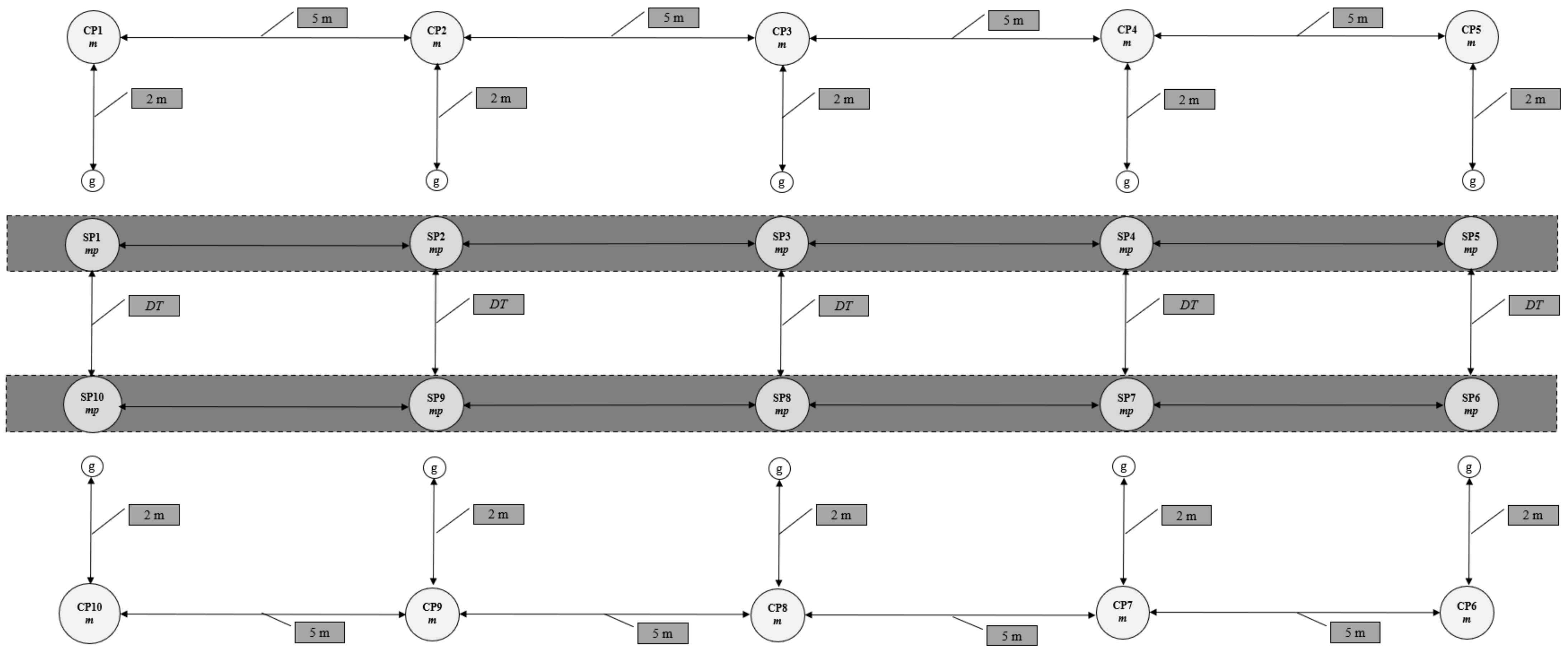
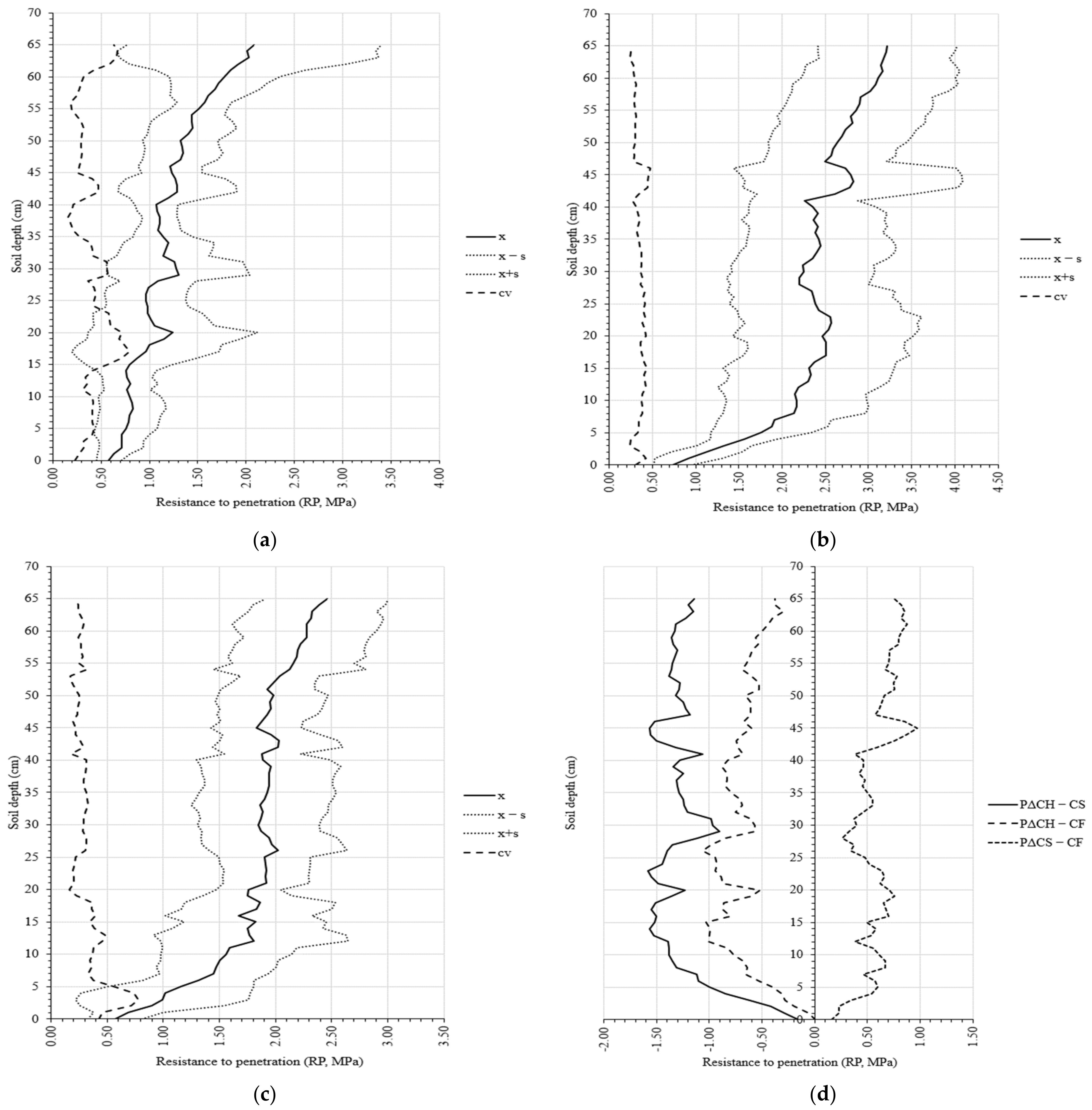


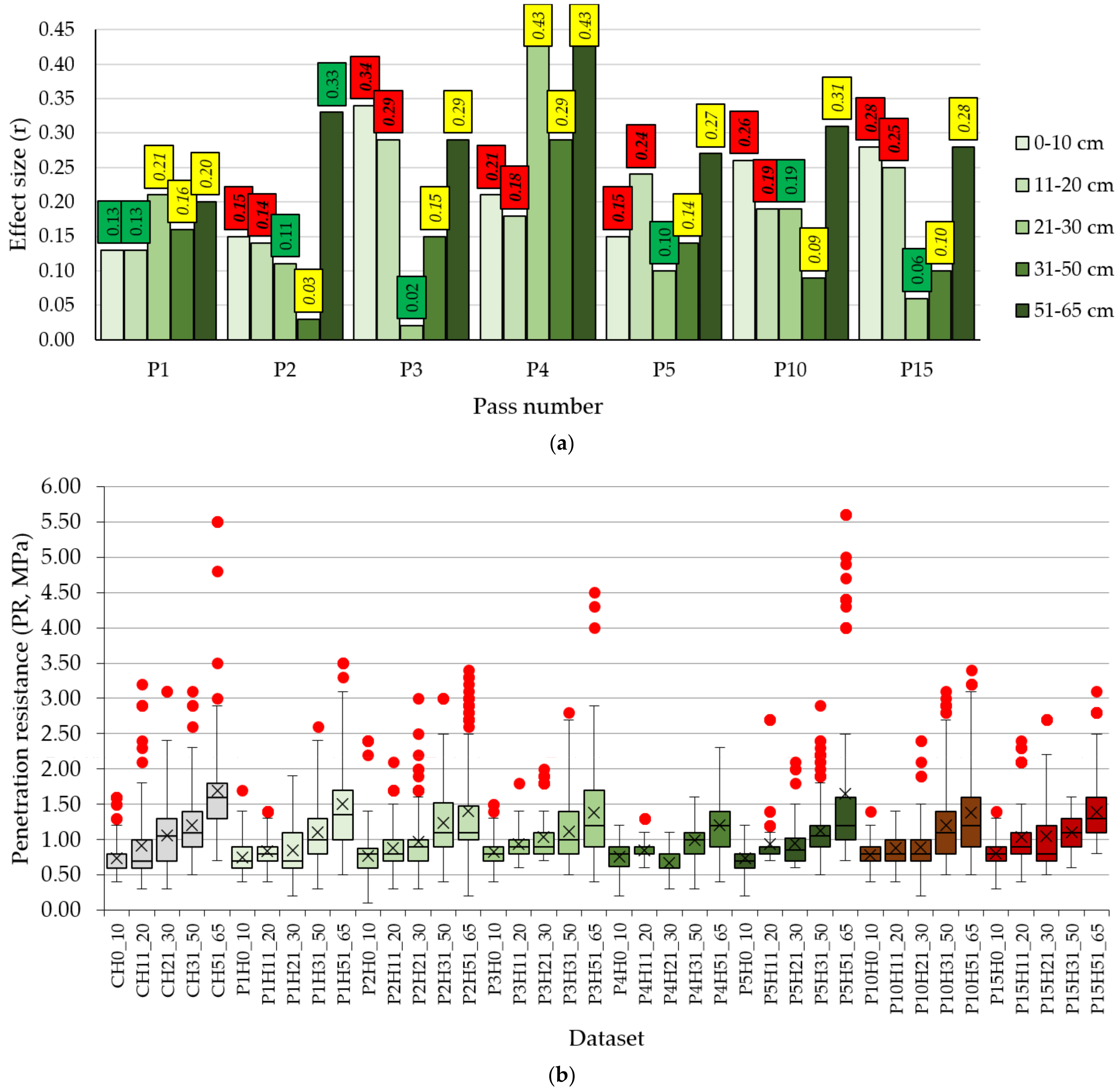
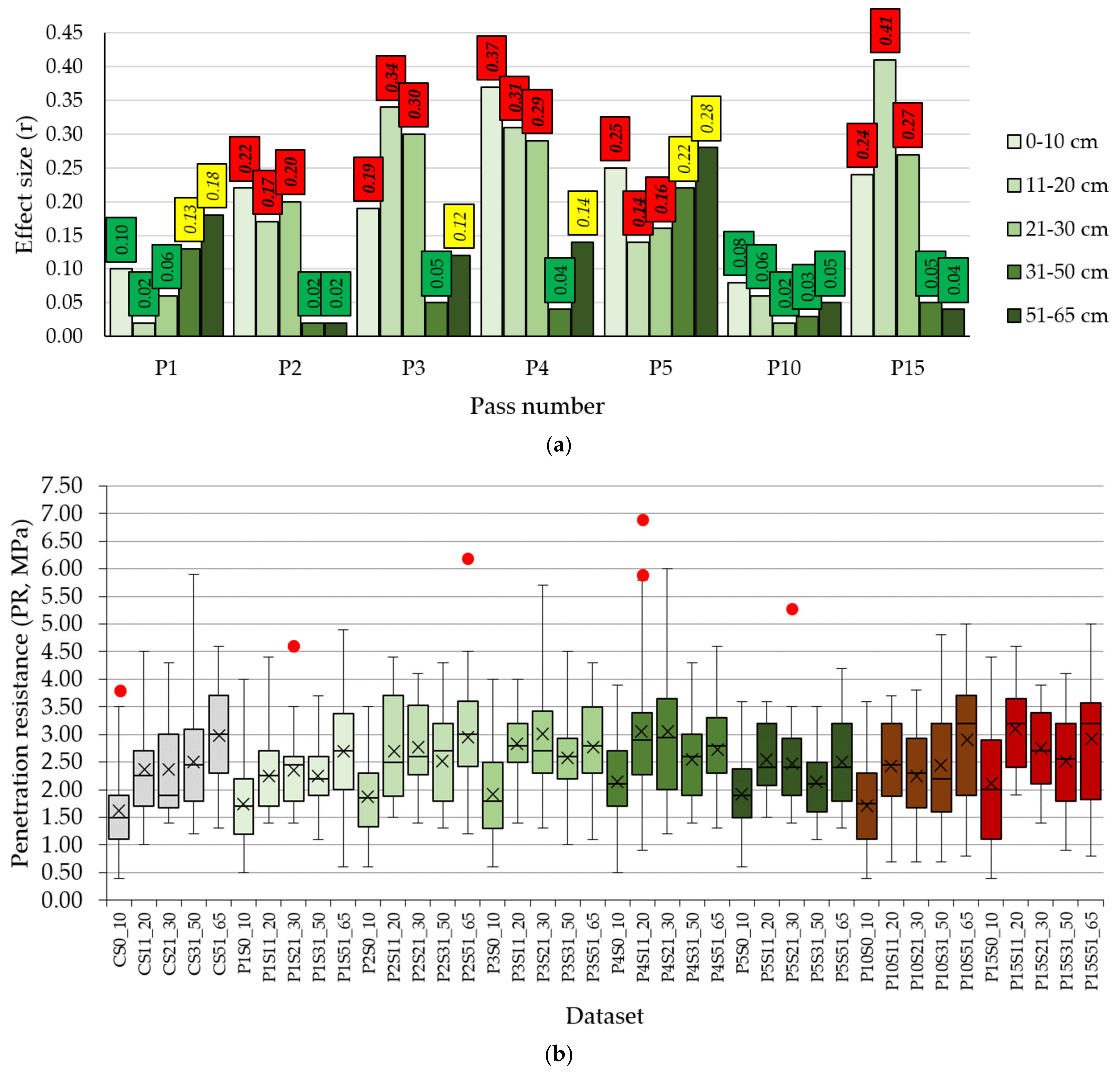
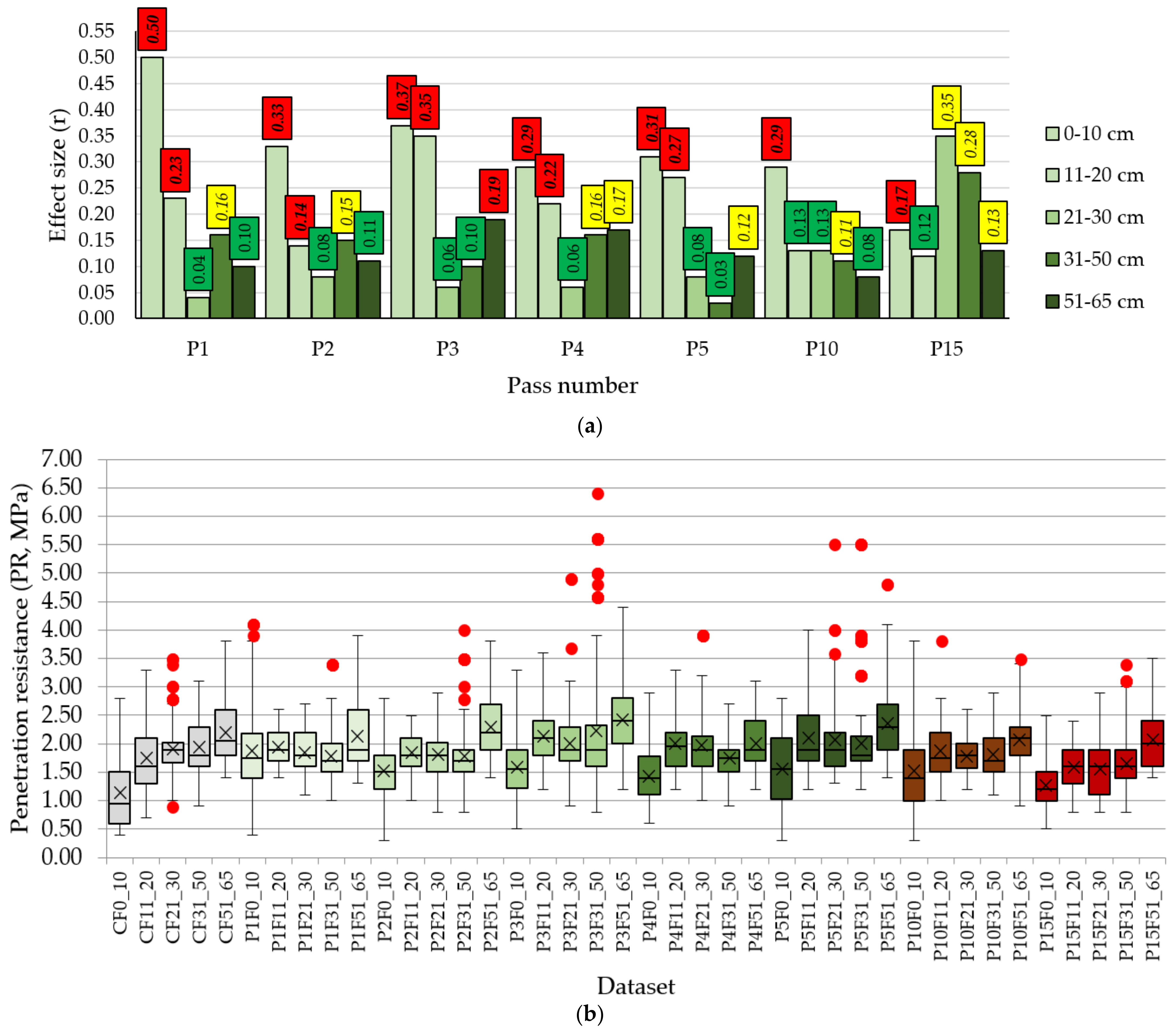
| Study Site | Soil Type 1 | Soil Horizons | Main Properties | Granulometry (%) | |||||||
|---|---|---|---|---|---|---|---|---|---|---|---|
| pH | MC (%) | Hy (%) | CaCO3 (%) | >0.2 mm (Coarse Sand, %) | 0.2–0.02 mm (Fine Sand, %) | 0.02–0.01 mm (Coarse Silt, %) | 0.01–0.0002 mm (Fine Silt, %) | <0.0002 mm (Clay, %) | |||
| H | Cambisol | Ao | 7.56 | 38.35 | 7.58 | 2.0 | 3.12 | 34.06 | 6.47 | 21.06 | 35.29 |
| Bv | 7.68 | 36.38 | 8.78 | 2.2 | 3.70 | 30.29 | 7.10 | 20.33 | 38.58 | ||
| C | 7.74 | 30.45 | 8.40 | 3.4 | 4.06 | 27.35 | 10.90 | 19.59 | 38.10 | ||
| C(R) | 7.82 | 29.72 | 9.38 | 4.0 | 4.14 | 27.59 | 10.61 | 18.63 | 39.03 | ||
| F | Cambisol | Ao | 4.62 | 28.57 | 8.75 | - | 5.23 | 33.62 | 3.55 | 15.20 | 42.40 |
| Bvw | 4.81 | 23.62 | 7.08 | - | 0.51 | 32.54 | 11.65 | 20.45 | 34.85 | ||
| Bv | 5.31 | 25.92 | 6.31 | - | 0.52 | 35.08 | 12.65 | 19.75 | 32.00 | ||
| C | 5.39 | 24.16 | 9.82 | - | 0.25 | 25.15 | 7.85 | 14.00 | 52.75 | ||
| S | Luvisol | Ao | 5.31 | 37.51 | 5.04 | - | 8.85 | 33.90 | 11.30 | 17.05 | 28.90 |
| El | 5.61 | 23.75 | 8.50 | - | 9.34 | 31.56 | 9.60 | 16.25 | 33.25 | ||
| Bt | 5.65 | 21.01 | 8.66 | - | 5.52 | 29.58 | 6.90 | 13.80 | 44.20 | ||
| Extraction Means | Type of Data | Number of Measurements Taken | Usable Probe Depth (cm) | Abbreviation of the Dataset |
|---|---|---|---|---|
| Horse | Control | 10 | 80 | HC |
| Horse | Pass #1 | 10 | 80 | HP1 |
| Horse | Pass #2 | 10 | 80 | HP2 |
| Horse | Pass #3 | 10 | 80 | HP3 |
| Horse | Pass #4 | 10 | 80 | HP4 |
| Horse | Pass #5 | 10 | 80 | HP5 |
| Horse | Pass #10 | 10 | 80 | HP10 |
| Horse | Pass #15 | 10 | 80 | HP15 |
| Forwarder | Control | 10 | 65 | FC |
| Forwarder | Pass #1 | 10 | 80 | FP1 |
| Forwarder | Pass #2 | 10 | 80 | FP2 |
| Forwarder | Pass #3 | 10 | 80 | FP3 |
| Forwarder | Pass #4 | 10 | 80 | FP4 |
| Forwarder | Pass #5 | 10 | 80 | FP5 |
| Forwarder | Pass #10 | 10 | 80 | FP10 |
| Forwarder | Pass #15 | 10 | 80 | FP15 |
| Skidder | Control | 10 | 80 | SC |
| Skidder | Pass #1 | 10 | 80 | SP1 |
| Skidder | Pass #2 | 10 | 80 | SP2 |
| Skidder | Pass #3 | 10 | 80 | SP3 |
| Skidder | Pass #4 | 10 | 80 | SP4 |
| Skidder | Pass #5 | 10 | 80 | SP5 |
| Skidder | Pass #10 | 10 | 80 | SP10 |
| Skidder | Pass #15 | 10 | 80 | SP15 |
Disclaimer/Publisher’s Note: The statements, opinions and data contained in all publications are solely those of the individual author(s) and contributor(s) and not of MDPI and/or the editor(s). MDPI and/or the editor(s) disclaim responsibility for any injury to people or property resulting from any ideas, methods, instructions or products referred to in the content. |
© 2024 by the authors. Licensee MDPI, Basel, Switzerland. This article is an open access article distributed under the terms and conditions of the Creative Commons Attribution (CC BY) license (https://creativecommons.org/licenses/by/4.0/).
Share and Cite
Presecan, M.F.; Forkuo, G.O.; Borz, S.A. Soil Compaction Induced by Three Timber Extraction Options: A Controlled Experiment on Penetration Resistance on Silty-Loamy Soils. Appl. Sci. 2024, 14, 5117. https://doi.org/10.3390/app14125117
Presecan MF, Forkuo GO, Borz SA. Soil Compaction Induced by Three Timber Extraction Options: A Controlled Experiment on Penetration Resistance on Silty-Loamy Soils. Applied Sciences. 2024; 14(12):5117. https://doi.org/10.3390/app14125117
Chicago/Turabian StylePresecan, Mădălina Florina, Gabriel Osei Forkuo, and Stelian Alexandru Borz. 2024. "Soil Compaction Induced by Three Timber Extraction Options: A Controlled Experiment on Penetration Resistance on Silty-Loamy Soils" Applied Sciences 14, no. 12: 5117. https://doi.org/10.3390/app14125117





